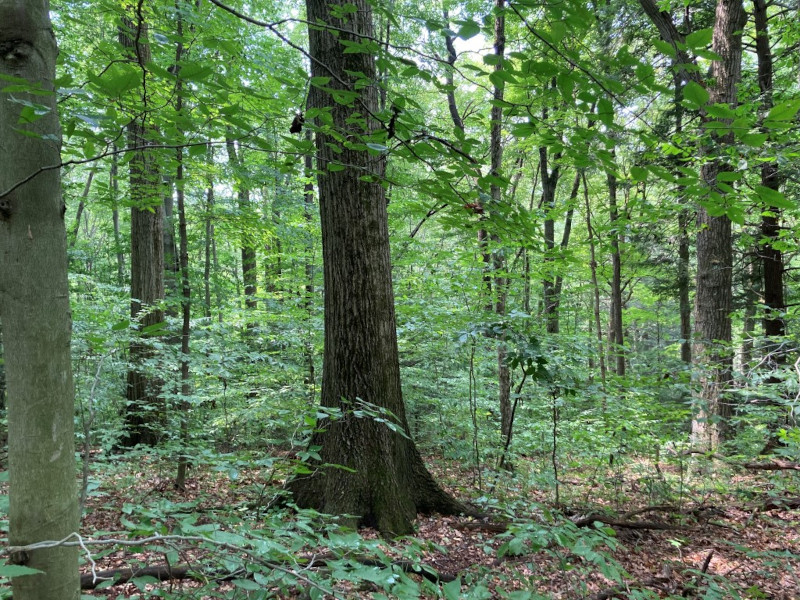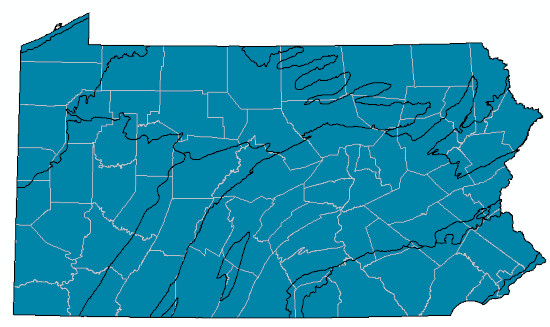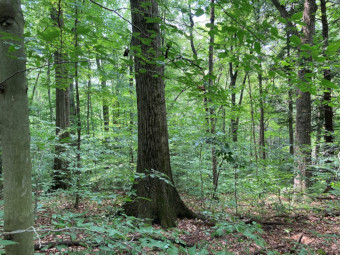Red Oak - Mixed Hardwood Forest
System: Terrestrial
Subsystem: Broadleaf Terrestrial Forest
PA Ecological Group(s):
Appalachian-Northeast Mesic Forest
Global Rank:G4
![]() rank interpretation
rank interpretation
State Rank: S3S4

General Description
This closed canopy forested community is found throughout Pennsylvania on a variety of landforms ranging from dry mid-to upper slopes and ridgetops to mesic lower slopes and coves.
The Red Oak – Mixed Hardwood Forest is broadly defined in Pennsylvania and has been widely mapped on state forest and game lands in Pennsylvania. This is a common, matrix-forming type of eastern North America. There are four different association-level communities dominated by northern red oak recognized in the National Vegetation Classification (USNVC) that are included within this forest type. These associations follow ecoregion and site-specific physiographical factors such as soils, elevation, and landform, which contribute to the variation in species composition. The four associations represented by the Red Oak – Mixed Hardwood Forest are tracked by the PA Natural Heritage Program separately; their SRanks are based on the range and number of occurrences, condition of occurrences, and threats. The Red Oak – Mixed Hardwood Forests of the Allegheny Plateau, and Central Appalachian Mountains and Piedmont ecoregions are relatively common matrix-forming forests in Pennsylvania. The association found at high elevations, and the association found on calcareous bedrock, are much less common. Pests, over browsing by white tailed deer, non-native invasive plants, and impacts of climate change are cause for long-term concern.
In all four Red Oak – Mixed Hardwood Forest types, northern red oak (Quercus rubra) dominates the canopy of hardwood tree species. In addition to the northern red oak, this forest type typically includes tuliptree (Liriodendron tulipifera), red maple (Acer rubrum), shagbark hickory (Carya ovata), sweet birch (Betula lenta), and American beech (Fagus grandifolia). Sugar maple (Acer saccharum) and white ash (Fraxinus americana) are often associates on richer sites. Shrubs and understory trees include maple-leaved viburnum (Viburnum acerifolium), shadbush (Amelanchier arborea), ironwood (Carpinus caroliniana), hophornbeam (Ostrya virginiana), witch-hazel (Hamamelis virginiana), gooseberry (Ribes cynosbati), and spicebush (Lindera benzoin). The herbaceous layer is variable. Wild oats (Uvularia sessilifolia), false Solomon’s-seal (Maianthemum racemosum), may-apple (Podophyllum peltatum), cucumber-root (Medeola virginiana), wood ferns (Dryopteris spp.), Labrador violet (Viola labradorica), short husk (Brachyelytrum erectum), cutleaf toothwort (Cardamine concatenata), two-leaved toothwort (C. diphylla), hay-scented fern (Dennstaedtia punctilobula]), common cinquefoil (Potentilla simplex), wax-flower shinleaf (Pyrola elliptica), Clayton’s sweet-root (Osmorhiza claytoniana), Christmas fern (Polystichum acrostichoides), sharp-lobed hepatica (Hepatica acutiloba), spring beauty (Claytonia virginica), wild geranium (Geranium maculatum), ground pine (Lycopodium obscurum]), and wood anemone (Anemone quinquefolia).
Within Red Oak – Mixed Hardwood Forests at higher elevations, particularly in the Allegheny Mountains, the forests are characterized by an absence of tuliptree, as it occurs above the elevational limits of this species; red maple may co-dominate these stands. For red oak-dominated forests on limestone geology, the forest patches often include calciphiles, which are not widely distributed in the state.
Rank Justification
The three varieties of the Red Oak – Mixed Hardwood Forest are tracked by the PA Natural Heritage Program separately; their S Ranks are based on the range and number of occurrences, condition of occurrences, and threats. The Red Oak – Mixed Hardwood Forest of the Western Allegheny Plateau, Central Appalachian Mountains, and High Allegheny Plateau ecoregions CEGL006635 is a relatively common matrix-forming forest of western, northern and central Pennsylvania. However, the association found at high elevations CEGL008570, and association of calcareous bedrock CEGL008578, are much less common. Thus, this type is considered S3-S4 (Apparently Secure) and not rare. However, the association found at high elevations CEGL008570, and association of calcareous bedrock CEGL008578, are much less common. Pests, over browsing, non-native invasive plants, and impacts of climate change are cause for long-term concern.
Globally, this is a common, matrix-forming type of eastern North America.
Identification
- Total tree canopy cover is over 70-80%
- Northern red oak is the dominant canopy tree
- Similar to Northern Hardwood Forests, but more oak and reduced maple cover; occasionally reduced birch and beech as well
Trees
- Northern red oak (Quercus rubra)
- Sugar maple (Acer saccharum)*
- White oak (Quercus alba)
- Tuliptree (Liriodendron tulipifera)
- Red maple (Acer rubrum)
- Yellow birch (Betula alleghaniensis)
- Black birch (Betula lenta)
- White ash (Fraxinus americana)*
- Canada hemlock (Tsuga canadensis)
- American beech (Fagus grandifolia)
Shrubs
- Maple-leaved viburnum (Viburnum acerifolium)
- Northern arrow-wood (Viburnum recognitum)
- Hornbeam (Carpinus caroliniana)
- Smooth serviceberry (Amelanchier laevis)
- Mountain laurel (Kalmia latifolia)
- Hop-hornbeam (Ostrya virginiana)
- Witch-hazel (Hamamelis virginiana)
- Spicebush (Lindera benzoin)
- Low sweet blueberry (Vaccinium angustifolium)
- Lowbush blueberry (Vaccinium pallidum)
Herbs
- Evergreen wood-fern (Dryopteris intermedia)
- Bellwort (Uvularia sessilifolia)
- False solomon's-seal (Maianthemum racemosum)
- Mayapple (Podophyllum peltatum)
- Pipsissewa (Chimaphila maculata)
- Teaberry (Gaultheria procumbens)
- Indian cucumber-root (Medeola virginiana)
- Canada mayflower (Maianthemum canadense)
- Blue cohosh (Caulophyllum thalictroides)
- Sedge (Carex pensylvanica)
- Hay-scented fern (Dennstaedtia punctilobula)
* limited to sites with higher soil calcium
Vascular plant nomenclature follows Rhoads and Block (2007). Bryophyte nomenclature follows Crum and Anderson (1981).
International Vegetation Classification Associations:
USNVC Crosswalk:
Central Appalachian-Northeast Red Oak – Mesic Hardwood Forest (A3303)
Pennsylvania’s Red Oak – Mixed Hardwood Forest includes forest communities dominated by
northern red oak and other hardwood species within NatureServe’s Central Appalachian-Northeast Red Oak – Mesic Hardwood Forest
Alliance. In all, there are five different associations attributed to Pennsylvania that share dominant species in the overstory,
but differ slightly with respect to the composition of the shrub and herbaceous layers. Two of these associations are recognized
in the USNVC and represent common matrix-forming forests of the Central Appalachian Mountains
and High Allegheny Plateau ecoregions of western, northern and central Pennsylvania. A third represents the northern red
oak-dominated forests of the Western Allegheny Plateau and Allegheny Mountains regions and has been proposed as a
new association in the USNVC. Two others, also recognized in the USNVC, are defined by specific geology or
elevational factors in the Allegheny Mountains, have more limited distributions (one occurring at higher elevations in the
Allegheny Mountains and a second limited to limestone and calcareous sandstone geology )
Red Oak - Transitional Northern Hardwood Forest (CEGL006635)
Central Appalachian Red Oak – Northern Hardwoods Forest (CEGL008570)
Central Appalachian Northern Hardwood Forest (Yellow Birch - Northern Red Oak Type) (CEGL008502)
Central Appalachian Calcareous Red Oak – Northern Hardwoods Forest (CEGL008578)
NatureServe Ecological Systems:
Appalachian (Hemlock) – Northern Hardwood Forest (CES202.593)
NatureServe Group Level:
Appalachian-Northeast Mesic Forest (G742)
Origin of Concept
Faber-Langedoen, D. 2021. Central Appalachian Red Oak - Northern Hardwoods Forest (CEGL008570). NatureServe Explorer [web application]. NatureServe, Arlington, Virginia. Available https://explorer.natureserve.org/. (Accessed: February 14, 2022).
Faber-Langedoen, D. 2021. Central Appalachian Calcareous Red Oak - Northern Hardwoods Forest (CEGL008578). NatureServe Explorer [web application]. NatureServe, Arlington, Virginia. Available https://explorer.natureserve.org/. (Accessed: February 14, 2022).
Faber-Langedoen, D. 2021. Lower New England Oak - Tuliptree Forest (CEGL008573). NatureServe Explorer [web application]. NatureServe, Arlington, Virginia. Available https://explorer.natureserve.org/. (Accessed: February 14, 2022).
Fike, J. 1999. Terrestrial and palustrine plant communities of Pennsylvania. Pennsylvania Natural Diversity Inventory. Harrisburg, PA. 86 pp.
Gawler, S. C. and Faber-Langendoen, D. 2014. Red Oak - Transitional Northern Hardwood Forest (CEGL006635). NatureServe Explorer [web application]. NatureServe, Arlington, Virginia. Available https://explorer.natureserve.org/. (Accessed: February 14, 2022).
Fike, J. 1999. Terrestrial and palustrine plant communities of Pennsylvania. Pennsylvania Natural Diversity Inventory. Pennsylvania Department of Conservation and Recreation, Bureau of Forestry, Harrisburg, PA. 86 pp.
Pennsylvania Community Code*
AR : Red Oak – Mixed Hardwood Forest
*(DCNR 1999, Stone 2006)
Similar Ecological Communities
This type can be very similar to the Northern Hardwood Forest type, which typically have less of a red oak/oak component, and more sugar maple, birch, beech, and black cherry. The Red Oak – Mixed Hardwood Forest is also similar to the Hemlock (white pine) – Red Oak – Mixed Hardwood Forest, but has greater (>25%) cover from hemlock or white pine. Hemlock – Tuliptree – Birch Forests share species, landscape context, and landform position with the Red Oak – Mixed Hardwood Forest, particularly the occurrences in the Allegheny Mountains. The Hemlock – Tuliptree – Birch Forests, however, have a greater proportion of hemlock in the overstory and rhododendron (Rhododendron maximum) in the tall shrub layer.
Fike Crosswalk
Red Oak – Mixed Hardwood Forest
Conservation Value
Oak is an economically important species, both regionally and nationally and has significant value for wildlife. A number of bird species that prefer forest interior conditions will occupy Red Oak – Mixed Hardwood Forests, including the American redstart (Setophaga ruticilla), black-throated blue warbler* (Setophaga caerulescens), eastern wood-pewee (Contopus virens), the yellow-bellied sapsucker (Sphyrapicus varius), hairy woodpecker (Leuconotopicus villosus), and hooded warbler* (Setophaga citrina); (Sargent et al., 2017). *SGCN species
Threats
While there are no short-term conservation risks for the Red Oak – Mixed Hardwood Forest community at this time, it could experience significant long-term changes to the composition or distribution in a changing climate. Some authors have suggested that species that are currently dominant in our northern hardwood forests spectrum, such as sugar maple, eastern hemlock, red maple, or black cherry, could become less common in both high and low emissions scenarios (Iverson et al., 2008). Other sources have suggested that some oak species, including red oak, have the potential to remain stable or increase across their native range in Pennsylvania (Peters et al., 2020). Forest pests/pathogens could significantly impact tree species in this community type, including spotted lanternfly (Lycorma delicatula), spongy moth (Lymantria dispar), eastern tent caterpillar (Malacosoma americanum), hemlock wooly adelgid (Adelges tsugae), emerald ash borer (Agrilus planipennis), and beech bark disease. Invasive plant species that threaten Red Oak – Mixed Hardwood Forests include garlic mustard (Alliaria petiolata) and Japanese barberry (Berberis thunbergii), among others. Throughout much of its range, the Red Oak – Mixed Hardwood Forest has experienced forest fragmentation from roads, shallow gas development, and habitat conversion. Furthermore, the core range of Red Oak – Mixed Hardwood Forest is found in the shale gas region in Pennsylvania, and potentially in West Virginia, Maryland, New York, and Ohio. Development of the shale gas region may result in additional fragmentation throughout the range in Pennsylvania. Because this type tends to grow on more mesic sites, there is a potential for climate-induced extreme drought to threaten this type.
Management
Red Oak – Mixed Hardwood Forests can be sustainably managed. However, forest conditions may require a specific plan to achieve management goals. Private landowners can consult with service foresters at the Pennsylvania Bureau of Forestry for more information on sustainable forest management practices that are best suited for their property. Management of invasive species is encouraged, and management of white-tailed deer could improve forest regeneration in forests experiencing high rate of herbivory.
Invasive plant species and deer herbivory are of particular concern within the Piedmont ecoregion of Pennsylvania, where the Red Oak – Mixed Hardwood Forest patches are smaller and occur much more commonly as forested woodlots within an agricultural or suburban landscape. Forests in these areas often exhibit signs of severe deer browsing and often lack characteristic understory and groundcover species, on all but the steepest of slopes where, deer pressure is reduced. Garlic mustard (Alliaria petiolata) and other non-native plant species are common in the ground cover within these stands.
Research Needs
In the context of climate change, monitoring of Red Oak – Mixed Hardwood Forests in northern Pennsylvania could benefit adaptive management efforts. Shifts in species dominance, particularly sugar maple, cherry, red maple, birch, and beech, could impact the distribution of hardwood communities as they are currently described (Bauer et al., 2016; Shortle et al., 2015). If red oak distribution remains stable, or if red oak begins to occupy more forested habitat as a result of climate change, red oak dominated forests could replace Northern Hardwood Forests in some parts of the state. Providing periodic updates to community mapping throughout Pennsylvania may be an effective monitoring tool in the future. Maintaining up-to-date maps of plant communities is both important for rare species as well as more common species for ecological modeling efforts.
Prescribed fire is becoming more commonly applied in oak forests, especially Dry Oak – Heath Forests and Dry Oak – Mixed Hardwood Forests. It is unclear if prescribed fire would benefit the Red Oak – Mixed Hardwood Forests in the same fashion as the drier oak-dominated types. It is assumed that more frequent fire would favor the red oak over the northern hardwood species, however more research is needed. Fire can be used responsibly as a tool for wildlife habitat management and forest management, and pre-and post-burn monitoring could help us better understand forest community response to fire.
Trends
Red Oak – Mixed Hardwood Forests account for approximately 10% of mapped acreage on public lands. Many studies (Abrams & Ruffner, 1995; Black et al., 2006; Johnson, 2013) have used historical vegetation records to determine that oak-dominated forests were common prior to European settlement. However, we have limited historical data for the distribution for red oak-dominated forests in Pennsylvania. Some authors have suggested that red oak and other species (see Abrams & Ruffner, 1995) may be replacing historically dominant species, such as white oak, hickory, white pine and American chestnut in the absence of fire or other disturbance in certain ecoregions (Abrams, 1992, 2003; Abrams & Nowacki, 1992; Abrams & Ruffner, 1995; Nowacki & Abrams, 2008; Signell et al., 2005).
Range Map

Pennsylvania Range
While we can find Red Oak – Mixed Hardwood Forests throughout Pennsylvania, regional variations exist. These correspond to specific association-level communities identified in the US NVC, which are found within different ecoregions of the state. The following regional variations, crosswalked to the USNVC are as follows:
The Red Oak – Mixed Hardwood Forest (Red Oak - Transitional Northern Hardwood Forest CEGL006635) has the widest distribution among the five red oak – mixed hardwood forest types. It can be found in the following USEPA Level III ecoregions: Western Allegheny Plateau Ecoregion (USEPA Level III Ecoregion 70), Allegheny Mountains (USEPA Level III Ecoregion 69), Ridge and Valley (USEPA Level III Ecoregion 67), North Central Appalachian Ecoregion (USEPA Level III Ecoregion 62), and Northern Appalachian Plateau (USEPA Level III Ecoregion 60).
The Red Oak – Mixed Hardwood Forest (Central Appalachian Red Oak – Northern Hardwoods Forest CEGL008570) and the Red Oak – Mixed Hardwood Forest (Central Appalachian Calcareous Red Oak – Northern Hardwoods Forest CEGL008578) are limited to USEPA’s Allegheny Mountains (USEPA Level III Ecoregion 69).
The Red Oak – Mixed Hardwood Forest (Western Allegheny Red Oak Forest) (CEGL00NEW1) can be found in the USEPA’s Western Allegheny Plateau Ecoregion (USEPA Level III Ecoregion 70) and Allegheny Mountains (USEPA Level III Ecoregion 69).
Global Distribution
Connecticut, Massachusetts, New Hampshire, New Jersey, New York, Pennsylvania, Rhode Island, West Virginia; Ontario
Abrams, M. D. (1992). Fire and the development of oak forests. BioScience, 42(5), 346–353.
Abrams, M. D. (2003). Where has all the white oak gone? BioScience, 53(10), 927–939.
Abrams, M. D., & Nowacki, G. J. (1992). Historical Variation in Fire, Oak Recruitment, and Post-Logging Accelerated Succession in Central Pennsylvania. Bulletin of the Torrey Botanical Club, 119(1), 19. https://doi.org/10.2307/2996916
Abrams, M. D., & Ruffner, C. M. (1995). Physiographic analysis of witness-tree distribution (1765–1798) and present forest cover through north central Pennsylvania. Canadian Journal of Forest Research, 25(4), 659–668. https://doi.org/10.1139/x95-073
Bauer, A., Farrell, R., & Goldblum, D. (2016). The geography of forest diversity and community changes under future climate conditions in the eastern United States. Ecoscience, 23, 41–53.
Black, B. A., Ruffner, C. M., & Abrams, M. D. (2006). Native American influences on the forest composition of the Allegheny Plateau, northwest Pennsylvania. Canadian Journal of Forest Research, 36(5), 1266–1275.
Iverson, L. R., Prasad, A. M., Matthews, S. N., & Peters, M. (2008). Estimating potential habitat for 134 eastern US tree species under six climate scenarios. Forest Ecology and Management, 254(3), 390–406.
Johnson, S. E. (2013). Native American land use legacies in the present day landscape of the Eastern United States. Ph.D. Dissertation. Pennsylvania State University.
Nowacki, G. J., & Abrams, M. D. (2008). The demise of fire and “mesophication” of forests in the Eastern United States. Bioscience, 58, 123–138.
Peters, M. P., Prasad, A. M., Matthews, S. N., & Iverson, L. R. (2020). Climate change tree atlas, Version 4. U.S. Forest Service, Northern Research Station and Northern Institute of Applied Climate Science, Delaware, OH. https://www.fs.fed.us/nrs/atlas/t
Sargent, S., Yeany III, D., Michel, N., & Zimmerman, E. (2017). Forest Interior Bird Habitat Relationships in the Pennsylvania Wilds, Final Report for WRCP-14507. Audubon Pennsylvania, National Audubon Society.
Shortle, J., Abler, D., Blumsack, S., Britson, A., Fang, K., Kemanian, A., Knight, P., McDill, M., Najjar, R., Nassry, M., Ready, R., Ross, A., Rydzik, M., Shen, C., Wardrop, D., & Yetter, S. (2015). Pennsylvania Climate Impacts Assessment Update. The Pen
Signell, S. A., Abrams, M. D., Hovis, J. C., & Henry, S. W. (2005). Impact of multiple fires on stand structure and tree regeneration in central Appalachian oak forests. Forest Ecology and Management, 218(1–3), 146–158. https://doi.org/10.1016/j.foreco.20
Cite as:
Zimmerman, E., and A. Hnatkovich. 2022. Pennsylvania Natural Heritage Program. Red Oak - Mixed Hardwood Forest Factsheet. Available from: https://naturalheritage.state.pa.us/Community.aspx?=16061 Date Accessed: January 14, 2026







